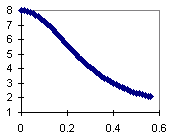
 |
Basic Maths for Protein Crystallographers |
| Form factors |
|
|
A single atom in a lattice will diffract with an amplitude proportional to its form factor f(i,S).
 |
Scattering curve for O (oxygen): electrons v d*. For a description/further explanation of this graph, see Crystallography 101 - Calculation of Atomic Scattering Factors |
The atom's diffracting power is further reduced at higher resolution by any atomic vibration (i.e. temperature factor), and the combined scattering is often labelled g(i,S). If the oscillation is isotropic
g(i,S) = f(i,S) e-BiS²
The diffraction "wave" from each atom for any given reflection will have a phase dependent on its position within the lattice. By convention the origin is chosen relative to the symmetry operators.
An atom's contribution can be expressed in various ways, often used concurrently in text books: